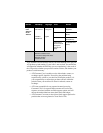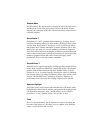28
Color Correction
Use Color Correction to correct discrepancies between the real color value
and the way a screen displays it. Color discrepancies can be caused by a
variety of sources, including the lighting conditions in the work area and
gradual shifts in color over time on monitors or flat panel displays.
Color Curve
A color curve represents all possible intensity values (from 0 to 255) for a
color component (Red, Green or Blue). For each color curve, the horizontal
axis represents the input value (the color value a program wants to display),
while the vertical axis represents the output value (the color value that the
display driver will write to the screen). A value of 0 (in the lower left
corner) represents the complete absence of that particular color, while a
value of 255 (in the upper right corner) represents the “full” strength for
that color.
CRT
Acronym for “cathode ray tube,” which is the main component of computer
monitors and TVs. Color CRTs use three separate electron beams fired
through a shadow mask and onto the back of the glass screen. The electron
beams activate separate red, green, and blue values in various strengths in
order to produce a colored image.
Dithering
A computer graphics technique that takes advantage of the human eye’s
tendency to mix two colors that are adjacent to each other to produce
smooth boundary transitions. Dithering adds intermediate color values
between two or more boundaries, producing smoother, more natural look
to 2D images or 3D objects.
Dual-Link DVI
A dual-link DVI transmits up to twice the amount of pixel information of
single link DVI connection. Use the dual-link DVI connector for extremely
high resolution displays such as Apple® 30-inch Cinema HD Displays.


















